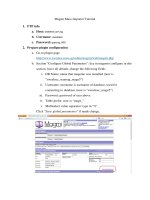scientific literature tutorial
Bạn đang xem bản rút gọn của tài liệu. Xem và tải ngay bản đầy đủ của tài liệu tại đây (2.29 MB, 52 trang )
Scientific
Literature
Tutorial
Introduction
The Parts of a Paper
Literature Cited
Peer Review
In this tutorial, you will learn:
What
peer-reviewed scientific literature is.
The components of a peer-reviewed research
paper.
How to cite a research paper.
Credits:
Figures and images by N. Wheat unless otherwise noted.
Stick figures from openclipart.org.
Science and Ecology cover shots from the respective websites.
Funded by Title V-STEM grant P031S090007.
Introduction
What
happens after scientists complete a
study? They’ve performed experiments,
analyzed their results, and perhaps even
decided what questions need to be addressed
next.
Introduction
Now
what? Their results aren’t very helpful if
nobody knows about them, so they must
communicate their results to the rest of the
scientific community.
Scientific Journals
When
scientists want to share the results of a
study, they do so by publishing their work in a
scientific journal. There are many journals
out there.
Scientific Journals
Some
are very general (Science, Nature) and
some are more specific (Ecology, Journal of
Experimental Marine Biology, Animal
Behaviour).
Scientific Journals
One
year of a journal is included in a volume.
Journals are published in several (4-12)
issues throughout the year.
Research Articles
Each
issue of a journal contains several
original research articles.
Check out the Table of Contents for the May/Ju
ne 2011 issue of Behavioral Ecology.
These
research articles are written by the
scientists that performed the research.
Question 1
How many original, full-length research
articles are found in this issue?
1
28
31
32
Question 1
Sorry!
That
is incorrect.
Try again!
Question 1
Congratulations!
You
are correct!
Popular Science Magazines
Some
publications contain
articles written by
professional science
writers.
They are writing about
research that others have
done.
The information in these
publications may be very
accurate, and well-written,
but they do not contain
peer-reviewed research
articles.
Question 2
Who writes peer-reviewed
original research articles?
Professional
science writers
The editor of the journal
The scientists that performed the
research
Other scientists working in the sam
e field as the scientists that did
the research
Question 2
Sorry!
That
is incorrect.
Try again!
Question 2
Congratulations!
You
are correct!
Format
Original
research articles in these journals
follow the same general format:
Title
Authors & Affiliation
Abstract
Methods
Results
Discussion/Conclusion
Acknowledgements
References/Literature Cited
Example Paper!
Use
this article as an example to examine the
parts of a research article.
As we look at each section of a paper, find it in
the example paper.
Title
Title
– A summarized statement of the
research. It should be written to help other
researchers find their study. Scientific names
of study species should be included when
applicable.
Authors
Authors
– If there are multiple authors listed
on a paper, they will be listed according to
workload. The author that did most of the
research & writing will be listed first. They are
not listed alphabetically.
Author Affiliation
Author
affiliation – The university or
institution where each author works. Note that
some authors may be affiliated with more than
one institution.
Question 3
In our example, where is the first
author, Robert Payne, affiliated?
Department
of Biology, University
of Michigan
Department of Biology, Hartnell C
ollege
Museum of Zoology, University of
Michigan
Both Department of Biology and M
useum of Zoology, University of
Michigan
Question 3
Sorry!
That
is incorrect.
Try again!
Question 3
Congratulations!
You
are correct!
Abstract
Abstract
– A summary of the research. The
abstract allows researchers to determine if the
paper is likely to contain the information they
are looking for. The abstract is often the last
thing that is written before submitting a paper.
Introduction
Introduction
– Background information on
the organism, the topic of study, and the study
site are found in the introduction. Prior
research on the topic should be detailed here.
All of the papers that are cited will have their
references listed at the end of the article. A
clearly stated hypothesis should also be
included here.









